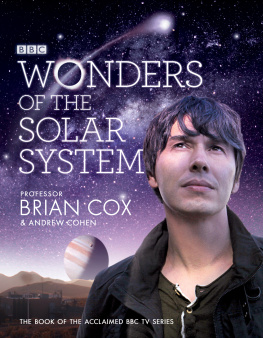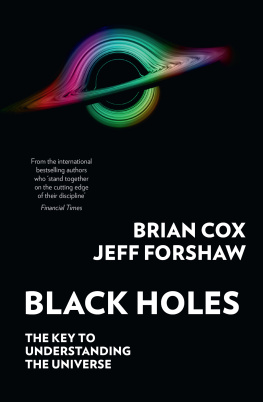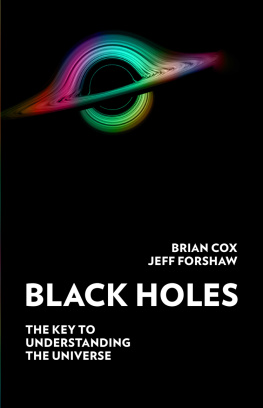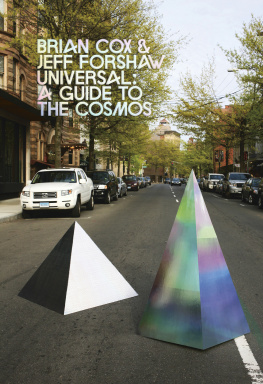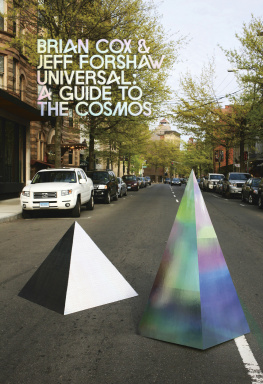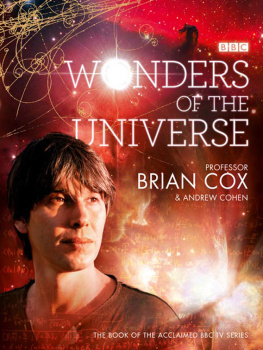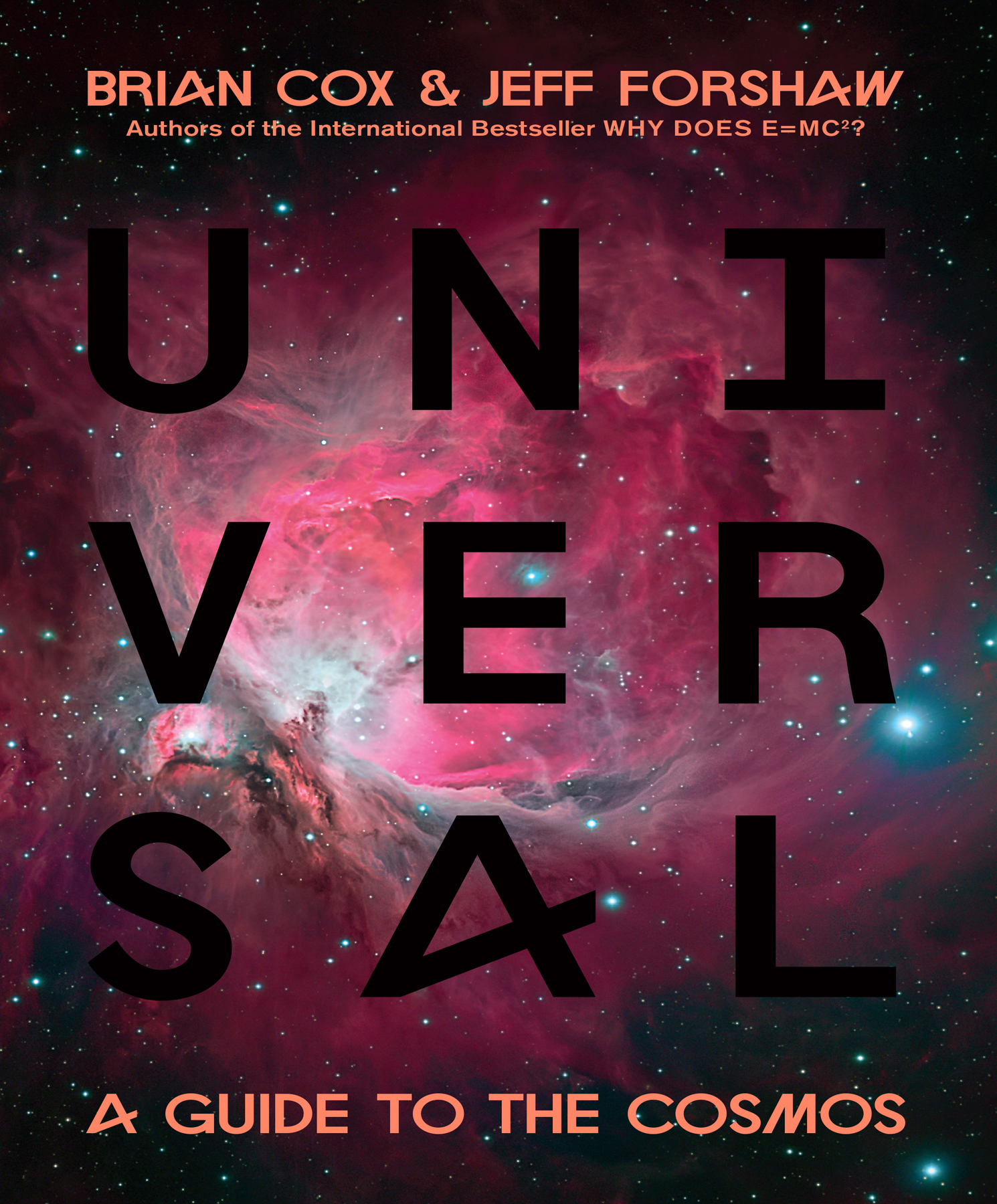For their specific help with various parts of the book, wed like to thank Richard Battye, Sarah Bridle, Mike Bowman, Bill & Pauline Chamberlain, Ed Copeland, Mrinal Dasgupta, Neal Jackson, Scott Kay, Kevin Kilburn, Peter Millington, Tim OBrien, Michael Oates, Subir Sarkar, Bob Seymour and Martin Yates. Particular thanks go to Mike Seymour, with whom we have had many enjoyable and helpful discussions.
Special thanks are also due to the team at Penguin and especially Tom Penn, our editor, and Tom Etherington, who produced the figures.
Thanks also to Diane and Sue for their continued guidance and support.
Finally, we would like to thank Peter Saville for his influence on the book, which extends beyond the beautiful cover design.
This book has been a long time in the making and we are deeply grateful for the support and encouragement of our families.
We dare to imagine a time when the entire observable Universe was compressed into a region of space smaller than an atom. And we can do more than just imagine. We can compute. We can compute how hundreds of billions of galaxies emerged from a single subatomic-sized patch of space dwarfed by a mote of dust, and there is precise agreement between those computations and our observations of the cosmos. It seems that human beings can know about the origins of the Universe.
Cosmology is surely the most audacious branch of science. The idea that the Milky Way, our home galaxy of 400 billion stars, was once compressed into a region so vanishingly small is outlandish enough. That the entire visible congregation of billions of galaxies once occupied such a subatomic-sized patch sounds like insanity. But to many cosmologists this claim isnt even mildly controversial.
This is not a book about knowledge handed down from on high. More than anything, it is about how weall of uscan gain an understanding of the Universe by doing science. You might think that its impossible for the average person to explore the Universe in much detail: dont we need access to Hubble Space Telescopes and Large Hadron Colliders? The answer is no, not always. Some fundamental questions about our Earth, our Sun, our solar system, and even the Universe beyond, are answerable from your back garden. How old are they? How big are they? How much do they weigh? We will answer these questions by doing science. We will observe, measure and think. One of the great joys of science is to understand something for the first timeto really understand, which is very different from, and far more satisfying than, knowing the facts. We will make our own measurements of the motion of Neptune, follow in the footsteps of the pioneering cosmologist Edwin Hubble in discovering that our Universe is expanding, and make an apparently trivial observation standing on a beach in south Wales.
As the book unfolds, our gaze will inevitably turn outwards towards the star-filled galaxies. To understand them, we will rely on observations and measurements that we cannot make ourselves. But we can imagine being a part of the teams of astronomers who can. How far away are the stars and galaxies? How big is the Universe? What is it made of? What was it like in the distant past? The answers to these questions will generate a cascade of new ideas, and, before the book is finished, we will be equipped to enquire about the origins of the Universe. Science is an enchanting journey of exploration. It is an exciting, rewarding process and one that leaves scientists with a feeling of being better connected to the world around them. It leaves a sense of awe and humility too; a feeling that the world is beautiful beyond imagination and that we are very privileged to be here to witness it.
Before we begin our journey, however, we will allow ourselves a glimpse of the destination. What follows next is the story of how our Universe evolved from a subatomic patch of space into the oceans of galaxies we see today. Perhaps, by the end of the book, you will judge that it might just be true.
Consider the Universe before the Big Bang. By Big Bang we mean a time 13.8 billion years ago when all the material that makes up the observable Universe came into being in the form of a hot, dense plasma of elementary particles. Before this time, the Universe was very different. It was relatively cold and devoid of particles, and space itself was expanding very rapidly, which means that any particles it may have contained were moving away from each other at high speeds. The average distance between particles was doubling every 1037 seconds. This is a staggering, almost incomprehensible, rate of expansion: two particles one centimetre apart at one instant were separated by 10 billion metres only 4 1036 seconds later; more than twenty times the distance from the Earth to the Moon. We do not know for how long the Universe expanded like this, but it continued for at least 1035 seconds. This pre-Big Bang phase of rapid expansion is known to cosmologists as the epoch of inflation.
Let us focus on a tiny speck of space a billion times smaller than a proton, the atomic nucleus of a hydrogen atom. At first glance, there is nothing particularly special about this tiny patch. It is one small part of a much larger, inflating Universe, and it looks much the same as all the other patches that surround it. The only reason this particular patch deserves our attention is that it is destined, over 13.8 billion years, to grow into our observable Universe: the region of space containing all the galaxies and quasars and black holes and stars and planets and nebulae visible from Earth today. The Universe is far bigger than the observable Universe, but we cant see it all because light can only travel a finite distance in 13.8 billion years.
Before the Big Bang, the Universe was filled with something called the inflaton field; a material thing, like a still ocean filling space. The gravitational effect of the energy stored in the inflaton field caused the Universes exponential expansion, and this is the origin of its name: it is the field responsible for inflating the Universe. On the whole, the inflaton field remained undisturbed as the Universe expanded, but it was not perfectly uniform. It had tiny ripples in it, as required by the laws of quantum physics.



